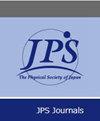通过 33S 核磁共振测量表征 SmS 中压力诱导半导体态的独特带状结构
IF 2.2
4区 物理与天体物理
Q2 PHYSICS, MULTIDISCIPLINARY
引用次数: 0
摘要
在近藤绝缘体中,只有在低温下才能形成一个小的能隙,用实验来阐明它们的电子结构是具有挑战性的,特别是在高压下。在本研究中,我们对一个具有小能隙的半导体相进行了高压33s核磁共振测量。为了分析由多个分量组成的核自旋-晶格弛豫时间T1的恢复曲线,引入了贝叶斯推理。基于简化的矩形能带模型和周期Anderson模型再现了1/T1独特的温度依赖性,该模型允许半定量地获得表征半导体状态的参数:导电电子和准粒子的带宽比SmB6更窄,能隙更小,而SmB6是典型的近道绝缘体。这种特殊的能带结构可能是由弱相关和较强杂化的特性引起的。本文章由计算机程序翻译,如有差异,请以英文原文为准。
Unique Band Structure of Pressure Induced Semiconducting State in SmS Characterized by 33S-Nuclear Magnetic Resonance Measurements
In Kondo insulators, where a small energy gap evolves only at low temperatures, it is challenging to experimentally clarify their electronic structures, especially under high pressure. In this study, we have carried out high-pressure 33S-nuclear magnetic resonance measurements on a pressure-induced semiconducting phase with a small energy gap of SmS. To analyze the recovery curve of nuclear spin–lattice relaxation time T1, consisting of multiple components, the Bayesian inference was introduced. The unique temperature dependence of 1/T1 is reproduced based on a simplified rectangular band model and a periodic Anderson model, which allows to obtain parameters characterizing the semiconducting state semi-quantitatively: the bandwidths of conduction electrons and quasiparticles are much narrower and the energy gap is smaller than for SmB6, a prototypical Kondo insulator. This peculiar band structure in the small gap state may arise from the characteristics of weak correlations and relatively strong hybridization.
求助全文
通过发布文献求助,成功后即可免费获取论文全文。
去求助
来源期刊
CiteScore
3.40
自引率
17.60%
发文量
325
审稿时长
3 months
期刊介绍:
The papers published in JPSJ should treat fundamental and novel problems of physics scientifically and logically, and contribute to the development in the understanding of physics. The concrete objects are listed below.
Subjects Covered
JPSJ covers all the fields of physics including (but not restricted to)
Elementary particles and fields
Nuclear physics
Atomic and Molecular Physics
Fluid Dynamics
Plasma physics
Physics of Condensed Matter
Metal, Superconductor, Semiconductor, Magnetic Materials, Dielectric Materials
Physics of Nanoscale Materials
Optics and Quantum Electronics
Physics of Complex Systems
Mathematical Physics
Chemical physics
Biophysics
Geophysics
Astrophysics.

 求助内容:
求助内容: 应助结果提醒方式:
应助结果提醒方式:


